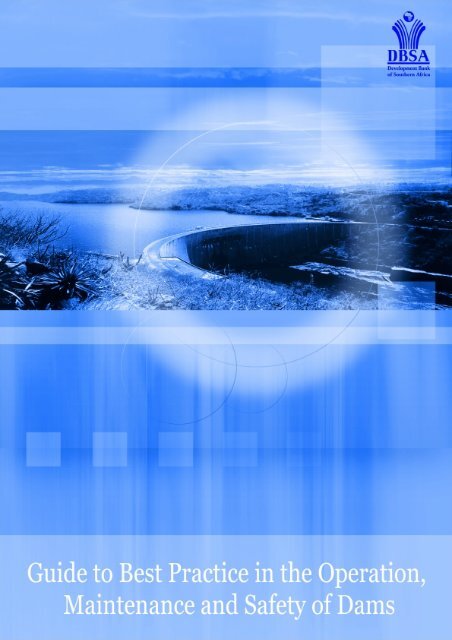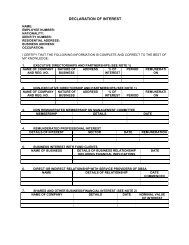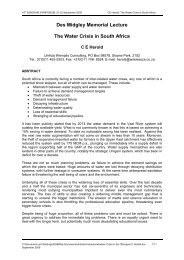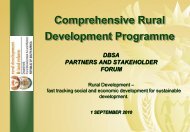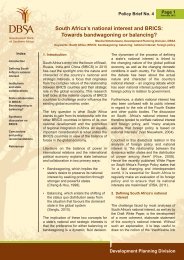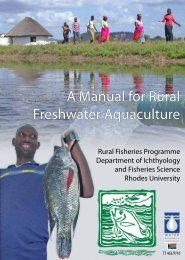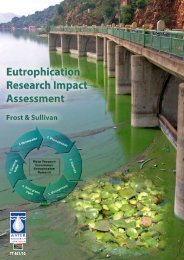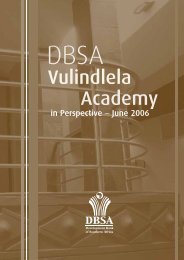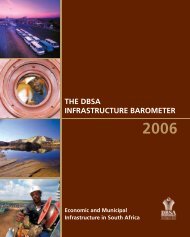Guide to best practice in the
Guide to best practice in the
Guide to best practice in the
You also want an ePaper? Increase the reach of your titles
YUMPU automatically turns print PDFs into web optimized ePapers that Google loves.
<strong>Guide</strong> <strong>to</strong> <strong>best</strong> <strong>practice</strong> <strong>in</strong> <strong>the</strong><br />
operation, ma<strong>in</strong>tenance and<br />
safety of dams<br />
Disclaimer<br />
In <strong>the</strong> preparation of this document, every effort has been made <strong>to</strong> offer <strong>the</strong> most current, correct and<br />
clearly expressed <strong>in</strong>formation possible. None<strong>the</strong>less, <strong>in</strong>advertent errors can occur, and applicable<br />
laws, rules and regulations may change. The Development Bank of Sou<strong>the</strong>rn Africa makes its<br />
documentation available without warranty of any k<strong>in</strong>d and accepts no responsibility for its accuracy<br />
or for any consequences of its use.<br />
Copyright<br />
All rights reserved. No part of this publication may be reproduced, s<strong>to</strong>red <strong>in</strong> a retrieval system, or transmitted, <strong>in</strong><br />
any form or by any means without <strong>the</strong> prior permission of <strong>the</strong> Development Bank of Sou<strong>the</strong>rn Africa.<br />
ISBN: 1-919692-60-6
B U I L D I N G K N O W L E D G E F O U N D A T I O N S F O R D E V E L O P M E N T<br />
Foreword<br />
Water is a scarce resource, which makes its management one of <strong>the</strong> greatest challenges fac<strong>in</strong>g us globally.<br />
In South Africa, water is a basic human right - but that right only applies <strong>to</strong> basic human needs and <strong>the</strong><br />
ma<strong>in</strong>tenance of environmental susta<strong>in</strong>ability.<br />
South Africa's development vision will only be realised if water resources are managed <strong>in</strong> a way that is<br />
sensitive and supportive of <strong>the</strong> many demands which we place upon those resources. The operations and<br />
ma<strong>in</strong>tenance of dams is a very essential component of sound and susta<strong>in</strong>able water resource management.<br />
South Africa has more than 500 large dams, which are used ma<strong>in</strong>ly for irrigation purposes and <strong>to</strong> supply<br />
urban areas with water.<br />
Although this guide was prepared for DBSA project teams <strong>in</strong>volved <strong>in</strong> dam projects, it can be a useful resource<br />
for dam owners and o<strong>the</strong>r people responsible for <strong>the</strong> operation and ma<strong>in</strong>tenance of dams. The guide<br />
<strong>in</strong>troduces <strong>the</strong> reader <strong>to</strong> measures aimed at improv<strong>in</strong>g <strong>the</strong> safety of new and exist<strong>in</strong>g dams so as <strong>to</strong> reduce<br />
<strong>the</strong> potential for harm <strong>to</strong> people, damage <strong>to</strong> property or resource quality.<br />
We welcome your contributions <strong>to</strong> this guide, which will be updated <strong>in</strong> <strong>the</strong> future based on new developments<br />
<strong>in</strong> <strong>the</strong> field.<br />
This guide was prepared by Brian Holl<strong>in</strong>gworth, Water Resource Management Specialist at <strong>the</strong> DBSA.<br />
Comments <strong>to</strong> <strong>the</strong> draft were provided by Willie Croucamp, Chief Direc<strong>to</strong>r - International projects, Department<br />
of Water Affairs and Forestry; Alan Chemaly - Chief Eng<strong>in</strong>eer, Dam Safety Office, Department of Water Affairs<br />
and Forestry; Peter Ballant<strong>in</strong>e, N<strong>in</strong>ham Shand (Pty) Ltd and Ken Jo<strong>in</strong>er, BKS (Pty) Ltd. Bheki Mpofu, Edi<strong>to</strong>r<br />
at <strong>the</strong> DBSA provided edi<strong>to</strong>rial support.
Table of Contents<br />
Page<br />
Introduction 1<br />
Management plan 2<br />
General context 3<br />
Operation 5<br />
Ma<strong>in</strong>tenance 8<br />
Dam Safety 10<br />
Dam safety regulations <strong>in</strong> South Africa 15<br />
Surveillance, Moni<strong>to</strong>r<strong>in</strong>g and Evaluation strategies 17<br />
Bibliography 19
B U I L D I N G K N O W L E D G E F O U N D A T I O N S F O R D E V E L O P M E N T<br />
1<br />
Introduction<br />
The DBSA has f<strong>in</strong>anced <strong>the</strong> implementation of fifteen large dams. In November 2000 <strong>the</strong> <strong>in</strong>ternational<br />
debate about <strong>the</strong> development effects of large dams culm<strong>in</strong>ated <strong>in</strong> <strong>the</strong> publication of <strong>the</strong> report of<br />
<strong>the</strong> World Commission on Dams (WCD). The WCD's "exam<strong>in</strong>ation of examples from Laos <strong>to</strong><br />
Malawi <strong>to</strong> Canada" demonstrated that effectively manag<strong>in</strong>g <strong>the</strong> operation of exist<strong>in</strong>g projects is<br />
a cost-effective approach <strong>to</strong>wards meet<strong>in</strong>g <strong>the</strong> economic, social and environmental needs of present<br />
and future generations.<br />
Dams potentially provide social and economic benefits but at <strong>the</strong> same time pose a threat <strong>to</strong> lives<br />
and livelihoods and <strong>the</strong> environment. Dam owners have a legal obligation, <strong>in</strong> most jurisdictions,<br />
<strong>to</strong> ensure that dams are operated <strong>in</strong> a way that optimises economic and social outputs while not<br />
compromis<strong>in</strong>g safety. This is a dynamic process that requires regular moni<strong>to</strong>r<strong>in</strong>g and review. The<br />
WCD, for example, advocates a comprehensive review of all exist<strong>in</strong>g dams <strong>to</strong> ensure that <strong>the</strong>y are<br />
optimally deliver<strong>in</strong>g benefits <strong>in</strong> an effective, efficient and equitable manner.<br />
Dam failure usually implies a breach of <strong>the</strong> wall and a catastrophic release of <strong>the</strong> s<strong>to</strong>red water. It<br />
may also be <strong>in</strong> a more economic sense as <strong>the</strong> reservoir fills up with sediment and <strong>the</strong> dam is no<br />
longer able <strong>to</strong> fulfil its s<strong>to</strong>rage function.<br />
The purpose of this guide is <strong>to</strong> outl<strong>in</strong>e some of <strong>the</strong> pr<strong>in</strong>cipal considerations that should guide DBSA<br />
project teams dur<strong>in</strong>g surveillance, moni<strong>to</strong>r<strong>in</strong>g and evaluation operations so that <strong>the</strong> purpose of <strong>the</strong><br />
dam cont<strong>in</strong>ues <strong>to</strong> be optimally achieved. It does not attempt <strong>to</strong> address <strong>the</strong> questions surround<strong>in</strong>g<br />
<strong>the</strong> broader development objective or project that <strong>the</strong> provision of water will enable. The guide<br />
is written from <strong>the</strong> perspective of a development f<strong>in</strong>ance <strong>in</strong>stitution and thus does not attempt <strong>to</strong><br />
deal with <strong>the</strong> many complex technical issues <strong>in</strong>herent <strong>to</strong> <strong>the</strong> <strong>to</strong>pic. The groundwork for most of<br />
<strong>the</strong> actions described here is laid dur<strong>in</strong>g <strong>the</strong> plann<strong>in</strong>g and design stages so that <strong>the</strong> guide <strong>in</strong>evitably<br />
refers <strong>to</strong> but does not exhaustively treat <strong>the</strong>se phases <strong>in</strong> <strong>the</strong> project cycle.<br />
The DBSA would normally regard <strong>the</strong> sett<strong>in</strong>g up of <strong>the</strong> operation, ma<strong>in</strong>tenance and safety systems<br />
as a part of project cost <strong>to</strong> be f<strong>in</strong>anced from <strong>the</strong> loan. It will be apparent from this guide that<br />
<strong>the</strong>re are considerable on-go<strong>in</strong>g costs that will have <strong>to</strong> be f<strong>in</strong>anced by <strong>the</strong> owner from o<strong>the</strong>r sources.<br />
The DBSA's practical experience <strong>in</strong> <strong>the</strong> field is limited so that most of <strong>the</strong> material is drawn from<br />
<strong>the</strong> WCD report, literature of <strong>the</strong> US Bureau of Reclamation and <strong>the</strong> International Commission on<br />
Large Dams (ICOLD) and from o<strong>the</strong>r sources. This guide should be used <strong>in</strong> conjunction with <strong>the</strong><br />
"<strong>Guide</strong> <strong>to</strong> Best Practice <strong>in</strong> Water Resources Development", <strong>the</strong> second revision of which was approved<br />
<strong>in</strong> February 2003.<br />
1 The International Congress on Large Dams def<strong>in</strong>es a large dam as hav<strong>in</strong>g a height of 15 metre or if 5 <strong>to</strong><br />
15 metre <strong>in</strong> height hav<strong>in</strong>g a capacity of greater than 3 million cubic metre.<br />
2 World Commission on Dams, Dams and Development - A new framework for decision mak<strong>in</strong>g,<br />
Earthscan Publications, November 2000.
Management Plan<br />
Like all substantial assets a large dam has <strong>to</strong> be effectively managed <strong>in</strong> a process sometimes referred<br />
<strong>to</strong> as <strong>in</strong>frastructure asset management. This <strong>in</strong>cludes a formal management, bus<strong>in</strong>ess or strategic<br />
plan that provides an overview of <strong>the</strong> various components that this guide deals with below <strong>in</strong> more<br />
detail. The management plan outl<strong>in</strong>es <strong>the</strong> year-<strong>to</strong>-year programme of actions and assigns responsibility<br />
for <strong>the</strong>ir <strong>in</strong>itiation. So, for example, <strong>the</strong> plan might set <strong>the</strong> <strong>in</strong>terval for dam safety <strong>in</strong>spections, name<br />
<strong>the</strong> official responsible for <strong>in</strong>itiat<strong>in</strong>g <strong>the</strong> work, determ<strong>in</strong>e whe<strong>the</strong>r a procurement process is needed<br />
for <strong>the</strong> <strong>in</strong>spec<strong>to</strong>r and many o<strong>the</strong>r general items. The plan will vary greatly with <strong>the</strong> type and size<br />
of <strong>the</strong> dam. An outl<strong>in</strong>e of such a plan could be:<br />
! Operations<br />
! Ma<strong>in</strong>tenance<br />
! Dam safety<br />
! Staff<strong>in</strong>g<br />
! Authority and responsibility<br />
! Record keep<strong>in</strong>g and document registers<br />
! Asset register<br />
! Procurement procedures<br />
! Occupational health and safety<br />
! Quality management programme<br />
! Report<strong>in</strong>g<br />
! Tra<strong>in</strong><strong>in</strong>g<br />
! General annual programme<br />
! Budget and f<strong>in</strong>ancial controls<br />
Each year <strong>the</strong> responsible person should report aga<strong>in</strong>st <strong>the</strong> plan and on <strong>the</strong> basis of this report <strong>the</strong><br />
plan should be updated, <strong>the</strong> ensu<strong>in</strong>g budgetary provisions determ<strong>in</strong>ed and <strong>the</strong> staff with <strong>the</strong><br />
necessary skills recruited.<br />
2B U I L D I N G K N O W L E D G E F O U N D A T I O N S F O R D E V E L O P M E N T
B U I L D I N G K N O W L E D G E F O U N D A T I O N S F O R D E V E L O P M E N T<br />
General Context<br />
Compliance<br />
The DBSA requires that all its projects be <strong>in</strong> compliance with all legal provisions. As far as <strong>the</strong> <strong>to</strong>pics<br />
of this guide are concerned, dam safety has attracted <strong>the</strong> attention of regula<strong>to</strong>rs <strong>in</strong> some SADC countries.<br />
However, <strong>the</strong>re are many o<strong>the</strong>r aspects of dam work that are regulated through<br />
o<strong>the</strong>r sec<strong>to</strong>rs, notably environmental management and occupational health and safety.<br />
Tra<strong>in</strong><strong>in</strong>g<br />
This guide addresses various processes, <strong>the</strong> value of which can only be realised if <strong>the</strong> opera<strong>to</strong>rs are<br />
thoroughly tra<strong>in</strong>ed <strong>in</strong> <strong>the</strong>ir use. Obta<strong>in</strong><strong>in</strong>g <strong>the</strong> maximum benefits from a large dam or be<strong>in</strong>g prepared<br />
for every eventuality dur<strong>in</strong>g emergency operation, requires ongo<strong>in</strong>g tra<strong>in</strong><strong>in</strong>g and management.<br />
The Relationship between Operation, Ma<strong>in</strong>tenance and Safety<br />
It is perhaps trite <strong>to</strong> po<strong>in</strong>t out that <strong>the</strong>se three functions are closely <strong>in</strong>ter-related. A poorly ma<strong>in</strong>ta<strong>in</strong>ed<br />
dam cannot be operated safely. There are, however, some digress<strong>in</strong>g objectives. So, for example, a<br />
dam safety <strong>in</strong>spection may not concern itself with whe<strong>the</strong>r s<strong>to</strong>red water is be<strong>in</strong>g efficiently used<br />
or that ancillary <strong>in</strong>frastructure is be<strong>in</strong>g poorly ma<strong>in</strong>ta<strong>in</strong>ed or that <strong>the</strong> fish ladder is dry. A public<br />
participation programme is essential on questions of operation but is probably much less important<br />
for ma<strong>in</strong>tenance. This guide separates <strong>the</strong> three processes for descriptive convenience but <strong>the</strong> key<br />
<strong>to</strong> <strong>the</strong>ir <strong>in</strong>tegration lies <strong>in</strong> <strong>the</strong> management processes <strong>in</strong> <strong>the</strong> <strong>in</strong>stitution of <strong>the</strong> dam owner.<br />
Management Issues and F<strong>in</strong>ance<br />
The guide is not <strong>in</strong>tended <strong>to</strong> address <strong>the</strong> general management and f<strong>in</strong>ance issues that surround<br />
operation, ma<strong>in</strong>tenance and safety. Clearly <strong>the</strong> assignment of responsibility and accountability and<br />
<strong>the</strong> provision of sufficient budget for all <strong>the</strong> processes outl<strong>in</strong>ed here, is axiomatic. Dam safety issues<br />
should not be compromised by f<strong>in</strong>ancial expediency.<br />
3
Documentation<br />
These guidel<strong>in</strong>es refer <strong>to</strong> a large volume of documents that form <strong>the</strong> basis for establish<strong>in</strong>g good<br />
<strong>practice</strong>. At every dam or with<strong>in</strong> <strong>the</strong> immediate vic<strong>in</strong>ity, a facility must be provided where <strong>the</strong><br />
documents can be readily available. This needs <strong>to</strong> be built with s<strong>to</strong>rage units able <strong>to</strong> protect <strong>the</strong><br />
documents for long periods. The documents should be duplicated at <strong>the</strong> head office of <strong>the</strong> owner.<br />
Record Keep<strong>in</strong>g<br />
Record keep<strong>in</strong>g and <strong>the</strong> associated report<strong>in</strong>g are critical <strong>in</strong> <strong>the</strong> efficient operation, effective<br />
ma<strong>in</strong>tenance and safety of dams. Each of <strong>the</strong> <strong>practice</strong>s referred <strong>to</strong> <strong>in</strong> this guide generate records<br />
that should be s<strong>to</strong>red <strong>in</strong> <strong>the</strong> document facility referred <strong>to</strong> above ei<strong>the</strong>r <strong>in</strong> electronic or orig<strong>in</strong>al<br />
format accord<strong>in</strong>g <strong>to</strong> stand<strong>in</strong>g <strong>in</strong>structions. Records should be duplicated <strong>in</strong> <strong>the</strong> head office of <strong>the</strong><br />
owner.<br />
Participation<br />
A large dam has many stakeholders. While <strong>the</strong> <strong>in</strong>teraction with most stakeholders decl<strong>in</strong>es on<br />
completion of <strong>the</strong> dam, many of <strong>the</strong> stakeholders who reta<strong>in</strong> an <strong>in</strong>terest rema<strong>in</strong>. This is particularly<br />
important if <strong>the</strong> dam should have unexpected consequences. The <strong>in</strong>teraction with stakeholders<br />
should be guided by a participation plan.<br />
B U I L D I N G K N O W L E D G E F O U N D A T I O N S F O R D E V E L O P M E N T<br />
4
B U I L D I N G K N O W L E D G E F O U N D A T I O N S F O R D E V E L O P M E N T<br />
Operation<br />
A dist<strong>in</strong>ction is usually drawn between <strong>the</strong> operation of <strong>the</strong> dam for its normal function of water<br />
supply (or hydropower generation) and that dur<strong>in</strong>g flood or emergency circumstances.<br />
Dam Operat<strong>in</strong>g Procedures<br />
Dam operat<strong>in</strong>g procedures (also known as "operat<strong>in</strong>g rules") refer <strong>to</strong> <strong>the</strong> circumstances <strong>in</strong> which<br />
controlled releases are made <strong>to</strong> ma<strong>in</strong>ta<strong>in</strong> <strong>the</strong> river environment and <strong>to</strong> supply users. The long-term<br />
yield of a dam is estimated us<strong>in</strong>g flow records and sophisticated modell<strong>in</strong>g techniques. The demand<br />
model usually takes <strong>in</strong><strong>to</strong> account monthly fluctuations. However, <strong>in</strong> real-time, demand for <strong>the</strong> next<br />
period depends on many fac<strong>to</strong>rs such as antecedent ra<strong>in</strong>fall, temperature and crop cycle. Under<br />
normal circumstances a weekly cycle of release plann<strong>in</strong>g is followed. It is good <strong>practice</strong> <strong>to</strong> draw<br />
up a set of procedures that guide <strong>the</strong> short-term releases from <strong>the</strong> dam. For example, when <strong>the</strong><br />
dam content falls below a certa<strong>in</strong> level at a particular time of <strong>the</strong> year, certa<strong>in</strong> users are rationed.<br />
The operat<strong>in</strong>g rules may be l<strong>in</strong>ked <strong>to</strong> o<strong>the</strong>r dams <strong>in</strong> a river bas<strong>in</strong> context. In critical drought periods it<br />
may be necessary <strong>to</strong> re-run or re-calibrate <strong>the</strong> hydrological and demand models.<br />
The operat<strong>in</strong>g procedures should be determ<strong>in</strong>ed through an <strong>in</strong>clusive consultative process, be<br />
unequivocal and well publicised.<br />
Floods<br />
On some dams, such as Maguga Dam on <strong>the</strong> Komati River <strong>in</strong> Swaziland, <strong>the</strong> opera<strong>to</strong>r has no control<br />
over <strong>the</strong> flow that goes over <strong>the</strong> spillway dur<strong>in</strong>g floods ("uncontrolled spillways"). O<strong>the</strong>r dams,<br />
such as Vaal Dam on <strong>the</strong> Vaal River <strong>in</strong> South Africa, are equipped with large floodgates so that <strong>the</strong><br />
opera<strong>to</strong>r can regulate <strong>the</strong> flow over <strong>the</strong> spillway ("controlled spillways"). There is a danger that<br />
with <strong>in</strong>correct operation <strong>the</strong> maximum flood released can actually be larger than <strong>the</strong> flow <strong>in</strong><strong>to</strong> <strong>the</strong><br />
dam. The objective of flood rout<strong>in</strong>g is <strong>to</strong> m<strong>in</strong>imise downstream damage without compromis<strong>in</strong>g <strong>the</strong><br />
safety of <strong>the</strong> dam. Dur<strong>in</strong>g large floods <strong>in</strong> river systems such as <strong>the</strong> Vaal River where several dams<br />
are <strong>in</strong>volved, <strong>the</strong> floods are routed from a control centre us<strong>in</strong>g real-time computer simulations. In<br />
times of such floods however <strong>the</strong> accompany<strong>in</strong>g adverse wea<strong>the</strong>r often renders communications less effective and<br />
<strong>the</strong> on-site opera<strong>to</strong>r has <strong>to</strong> be equipped with <strong>the</strong> manuals and tra<strong>in</strong><strong>in</strong>g that will enable him <strong>to</strong> <strong>in</strong>dependently take<br />
<strong>the</strong> correct measures when necessary.<br />
5
Emergency Procedures<br />
The emergency preparedness plan (EPP), describes <strong>the</strong> circumstances under which emergency<br />
procedures are <strong>in</strong>voked and what is <strong>to</strong> be done by various persons. Emergencies may arise dur<strong>in</strong>g<br />
extreme floods, on <strong>the</strong> observation of excessive seepage or o<strong>the</strong>r causes depend<strong>in</strong>g on <strong>the</strong> design<br />
of <strong>the</strong> dam. The personnel at <strong>the</strong> dam would rarely have <strong>the</strong> skills <strong>to</strong> deal with emergencies on<br />
<strong>the</strong>ir own so that <strong>the</strong> emergency plan is characterised by describ<strong>in</strong>g <strong>the</strong> circumstances under which<br />
various <strong>in</strong>dividuals or disaster management authorities are notified. At <strong>the</strong> core of this approach<br />
is <strong>the</strong> need <strong>to</strong> ma<strong>in</strong>ta<strong>in</strong> current contact details and <strong>to</strong> place this contact list <strong>in</strong> a prom<strong>in</strong>ent place.<br />
Disaster management authorities would similarly have an emergency action and evacuation plan (EAP).<br />
Experience <strong>in</strong>dicates that <strong>the</strong> implementation of an emergency preparedness plan requires extensive<br />
and on-go<strong>in</strong>g <strong>in</strong>teraction with and tra<strong>in</strong><strong>in</strong>g of all role-players.<br />
Equipment<br />
A dam is equipped with mechanical and electrical equipment. This may vary from small electronic<br />
<strong>in</strong>struments <strong>to</strong> large floodgates. The opera<strong>to</strong>r must have access <strong>to</strong> <strong>the</strong> manufacturer's <strong>in</strong>structions<br />
for every piece of equipment on <strong>the</strong> dam.<br />
Warn<strong>in</strong>g Systems<br />
Dur<strong>in</strong>g flood operation or an emergency <strong>the</strong>re must be a plan for alert<strong>in</strong>g or evacuat<strong>in</strong>g people from<br />
<strong>the</strong> danger areas. This is usually <strong>the</strong> responsibility of <strong>the</strong> civilian authorities <strong>in</strong> <strong>the</strong> area. The emergency<br />
preparedness plan at <strong>the</strong> dam must be meticulously kept up <strong>to</strong> date and <strong>in</strong>clude all <strong>the</strong> contact details<br />
of <strong>the</strong> responsible disaster management authorities. All parties concerned must understand <strong>the</strong><br />
circumstances under which a notification is given so that <strong>the</strong> plan is usually <strong>the</strong> product of negotiation.<br />
The warn<strong>in</strong>g system must be complete before <strong>the</strong> dam is filled for <strong>the</strong> first time.<br />
B U I L D I N G K N O W L E D G E F O U N D A T I O N S F O R D E V E L O P M E N T<br />
6
B U I L D I N G K N O W L E D G E F O U N D A T I O N S F O R D E V E L O P M E N T<br />
First Fill<strong>in</strong>g<br />
The first fill<strong>in</strong>g of a dam is a critical period dur<strong>in</strong>g which special procedures are adopted <strong>to</strong><br />
ensure dam safety. A survey by ICOLD 3 reported that of 167 dam failures <strong>in</strong>vestigated, 35<br />
occurred dur<strong>in</strong>g first fill<strong>in</strong>g. One example of such a special procedure is that, it is desirable<br />
<strong>to</strong> fill <strong>the</strong> dam slowly. These procedures cannot be compromised by <strong>the</strong> need <strong>to</strong> br<strong>in</strong>g <strong>the</strong><br />
dam <strong>in</strong><strong>to</strong> effective operation as rapidly as possible for f<strong>in</strong>ancial reasons. It is good <strong>practice</strong><br />
(and required by SA dam safety regulations) for <strong>the</strong> operat<strong>in</strong>g procedures manual <strong>to</strong> have been<br />
completed before first fill<strong>in</strong>g commences. These are supplemented by special arrangements<br />
dur<strong>in</strong>g first fill<strong>in</strong>g. Dur<strong>in</strong>g <strong>the</strong> <strong>in</strong>itial phases of fill<strong>in</strong>g <strong>the</strong> emergency plans are usually <strong>in</strong>voked<br />
<strong>to</strong> <strong>the</strong> status of an alert.<br />
Environmental Management Plan (EMP)<br />
The EMP derives from <strong>the</strong> environmental impact assessment undertaken dur<strong>in</strong>g <strong>the</strong> plann<strong>in</strong>g phase<br />
and leads on from <strong>the</strong> EMP followed dur<strong>in</strong>g <strong>the</strong> construction phase. It must deal with <strong>the</strong> dam wall,<br />
<strong>the</strong> lake, <strong>the</strong> river downstream and o<strong>the</strong>r areas such as access roads. The plan will deal with a large<br />
range of <strong>to</strong>pics from <strong>the</strong> protection or conservation of sensitive areas <strong>to</strong> <strong>the</strong> control of weeds and<br />
disease vec<strong>to</strong>rs that may be encouraged by <strong>the</strong> lake. Most jurisdictions have regula<strong>to</strong>ry provisions<br />
deal<strong>in</strong>g with environmental management. The DBSA has a separate guidel<strong>in</strong>e for <strong>the</strong><br />
Development and Implementation of Project Specific Environmental Management Plans 4 .<br />
Susta<strong>in</strong>able Utilisation Plan<br />
The dam and <strong>the</strong> lakeshore often represent an economic asset. Frequently a considerable area<br />
that can be exploited for recreation and o<strong>the</strong>r purposes lies between <strong>the</strong> full supply level of<br />
a dam and <strong>the</strong> higher flood levels. At least a zon<strong>in</strong>g plan for <strong>the</strong> lakeshore should be <strong>in</strong>cluded<br />
or produced separately. Best <strong>practice</strong> now requires <strong>the</strong> preparation of a plan referred <strong>to</strong> as a<br />
susta<strong>in</strong>able utilisation plan. If this is produced dur<strong>in</strong>g <strong>the</strong> time when mitigation measures are<br />
designed, <strong>the</strong> allocation of <strong>the</strong> benefits can form part of <strong>the</strong> mitigation measures.<br />
3 ICOLD, Dam failures - Statistical analysis, ICOLD Bullet<strong>in</strong> No 99<br />
4 DBSA , <strong>Guide</strong>l<strong>in</strong>e for <strong>the</strong> Development and Implementation of Project Specific Environmental<br />
Management Plans, 2001.<br />
7
Records<br />
The operat<strong>in</strong>g procedures detail <strong>the</strong> records that are <strong>to</strong> be kept, how <strong>the</strong>y are processed, <strong>to</strong> whom<br />
<strong>the</strong>y are referred for review and how <strong>the</strong>y are achieved.<br />
Occupational Safety<br />
The operation of some of <strong>the</strong> equipment on large dams may entail enter<strong>in</strong>g hazardous locations.<br />
Warn<strong>in</strong>g signs must be erected at all such locations and <strong>the</strong> opera<strong>to</strong>rs must have readily available<br />
<strong>the</strong> <strong>to</strong>ols and protective equipment needed <strong>to</strong> safely operate <strong>the</strong> equipment while be<strong>in</strong>g protected<br />
aga<strong>in</strong>st any hazards. Similarly <strong>the</strong>re should be plans for treat<strong>in</strong>g or evacuat<strong>in</strong>g <strong>in</strong>jured workers.<br />
Ma<strong>in</strong>tenance<br />
The Nature of Ma<strong>in</strong>tenance Management<br />
Ma<strong>in</strong>tenance is undertaken <strong>to</strong> ensure that <strong>the</strong> dam is safe, that all elements of <strong>the</strong> dam will perform<br />
optimally and that <strong>the</strong> value of <strong>the</strong> asset is preserved. The approach should follow general ma<strong>in</strong>tenance<br />
<strong>practice</strong>, with adaptations <strong>to</strong> <strong>the</strong> special nature of dams and particularly <strong>to</strong> <strong>the</strong> dam safety aspects.<br />
The potential range of ma<strong>in</strong>tenance activities for dams varies greatly from project <strong>to</strong> project so that<br />
an exhaustive treatment here is not possible. Some of <strong>the</strong> general categories are:<br />
! Mechanical equipment e.g. oil<strong>in</strong>g, greas<strong>in</strong>g, pa<strong>in</strong>t<strong>in</strong>g;<br />
! Electrical equipment e.g. clean<strong>in</strong>g, safety checks;<br />
! Electronic equipment e.g. telecommunications, <strong>in</strong>strumentation;<br />
! Occupational safety e.g. functionality of safety equipment such as handrails;<br />
! Vegetation e.g. prevention of trees on embankment dams;<br />
! Public amenities and safety e.g. signage, fenc<strong>in</strong>g, roads, pathways, security;<br />
! Build<strong>in</strong>gs e.g. pump stations;<br />
! Miscellaneous items e.g. clean<strong>in</strong>g <strong>the</strong> trash racks, keep<strong>in</strong>g dra<strong>in</strong>age paths clear; and<br />
! Animals, verm<strong>in</strong> and birds. Animals can burrow through earth embankments, verm<strong>in</strong> can chew<br />
through electrical circuits and birds can soil <strong>in</strong>stallations.<br />
As with operations a comprehensive ma<strong>in</strong>tenance manual is required that details and schedules all<br />
ma<strong>in</strong>tenance actions. The manufacturer's manuals for specialised equipment must be <strong>in</strong>cluded or<br />
be readily available.<br />
B U I L D I N G K N O W L E D G E F O U N D A T I O N S F O R D E V E L O P M E N T<br />
8
B U I L D I N G K N O W L E D G E F O U N D A T I O N S F O R D E V E L O P M E N T<br />
Ma<strong>in</strong>tenance Management Systems<br />
The ma<strong>in</strong>tenance management system consists of a number of sub systems:<br />
! A design phase that should commence at <strong>the</strong> earliest possible time and must be complete<br />
before <strong>the</strong> dam is taken <strong>in</strong><strong>to</strong> operation;<br />
! The manuals that document <strong>the</strong> what, how, who and when issues;<br />
! The rout<strong>in</strong>e <strong>in</strong>spection system that determ<strong>in</strong>es whe<strong>the</strong>r <strong>the</strong> programme is be<strong>in</strong>g implemented<br />
and that it is hav<strong>in</strong>g <strong>the</strong> <strong>in</strong>tended effect;<br />
! The dam safety <strong>in</strong>spection system that determ<strong>in</strong>es whe<strong>the</strong>r <strong>the</strong>re are any threats <strong>to</strong> <strong>the</strong> dam's<br />
safety and consequently any ma<strong>in</strong>tenance or upgrade requirements;<br />
! A review and upgrade system that strives for cont<strong>in</strong>ual improvement;<br />
! The record-keep<strong>in</strong>g system; and<br />
! The <strong>in</strong>stitutional structure that def<strong>in</strong>es policy and assigns responsibility and accountability.<br />
Route Test<strong>in</strong>g<br />
Included <strong>in</strong> <strong>the</strong> ma<strong>in</strong>tenance plan should be <strong>the</strong> schedules for <strong>the</strong> periodic test<strong>in</strong>g of EVERY piece<br />
of equipment on <strong>the</strong> project. This should be under <strong>the</strong> full range of design operat<strong>in</strong>g conditions.<br />
So for example, a floodgate should be test operated under both dry and reservoir full conditions<br />
even if <strong>the</strong> latter test is of short duration or not necessarily over its full operat<strong>in</strong>g range.<br />
Staff<strong>in</strong>g<br />
It would be unusual for <strong>the</strong> staff with <strong>the</strong> full range of skills necessary for all <strong>the</strong> tasks <strong>to</strong> be stationed<br />
on site. In fact, smaller dams may have no on-site staff. Hence it is necessary <strong>to</strong> keep a register of specialised<br />
skills and <strong>to</strong> contract <strong>the</strong>se as required or <strong>to</strong> engage on a cont<strong>in</strong>gency basis. Cont<strong>in</strong>uity,<br />
regularity specific knowledge of <strong>the</strong> project should be <strong>the</strong> guid<strong>in</strong>g concepts.<br />
9
To Deficiencies<br />
Where rout<strong>in</strong>e <strong>in</strong>spections reveal deficiencies, <strong>the</strong> ma<strong>in</strong>tenance plan should set out <strong>the</strong> procedures<br />
<strong>to</strong> have <strong>the</strong>m repaired timeously. The authority <strong>to</strong> order repairs must be clear at all times.<br />
Where a deficiency threatens <strong>the</strong> safety of <strong>the</strong> dam <strong>the</strong> decision-maker should be able <strong>to</strong> over-ride<br />
budgetary and o<strong>the</strong>r bureaucratic processes that might leave <strong>the</strong> dam's safety under threat for<br />
extended periods.<br />
Spares and Standby<br />
The ma<strong>in</strong>tenance programme needs <strong>to</strong> <strong>in</strong>clude a policy on <strong>the</strong> hold<strong>in</strong>g of spares and standby<br />
equipment that takes <strong>in</strong><strong>to</strong> account <strong>the</strong> availability and proximity of spares, any potential disruptions<br />
<strong>to</strong> transport routes dur<strong>in</strong>g emergencies such as flood events, <strong>the</strong> criticalness of <strong>the</strong> equipment <strong>in</strong><br />
emergency conditions and <strong>the</strong> general questions of cost tradeoffs.<br />
Dam Safety<br />
General<br />
There has been a relatively low <strong>in</strong>cidence of <strong>the</strong> catastrophic failure of large dams <strong>in</strong> South Africa.<br />
On <strong>the</strong> o<strong>the</strong>r hand <strong>the</strong>re have been many failures of small "farm dams" where standards of eng<strong>in</strong>eer<strong>in</strong>g<br />
have not been followed or have been <strong>in</strong>adequate. The DBSA funded <strong>the</strong> 38 metre high Zoeknog<br />
Dam for <strong>the</strong> <strong>the</strong>n government of Lebowa, which failed on January 23 1993, dur<strong>in</strong>g its first fill<strong>in</strong>g;<br />
fortunately without loss of life 5 . Internationally, <strong>the</strong>re have been at least three dam failures<br />
that caused <strong>the</strong> death of more than 2000 people. The most no<strong>to</strong>rious and unusual failure is usually cited<br />
as <strong>the</strong> Vaiont Dam, a high arch structure <strong>in</strong> Italy.<br />
5 Lebowa Government, Department of Agriculture and Environmental Conservation, Branch: Water Affairs,<br />
Investigation concern<strong>in</strong>g <strong>the</strong> failure of Zoeknog Dam: Pert<strong>in</strong>ent Information, Report No.<br />
1455/6057, March 1994.<br />
B U I L D I N G K N O W L E D G E F O U N D A T I O N S F O R D E V E L O P M E N T<br />
10
B U I L D I N G K N O W L E D G E F O U N D A T I O N S F O R D E V E L O P M E N T<br />
A mounta<strong>in</strong>side slipped <strong>in</strong><strong>to</strong> <strong>the</strong> reservoir along a geological weakness that had been fur<strong>the</strong>r aggravated by<br />
seepage water from <strong>the</strong> reservoir. The material caused a wave 100m high <strong>to</strong> pass over <strong>the</strong> dam wall, result<strong>in</strong>g <strong>in</strong><br />
extensive destruction of downstream homes and <strong>the</strong> loss of 2600 lives. Ironically, <strong>the</strong> structure never failed and<br />
Vaiont Dam still stands, but rema<strong>in</strong>s full of earth and unused.<br />
Studies commissioned by ICOLD 6 have revealed that <strong>the</strong> failure rate of large dams has been fall<strong>in</strong>g<br />
over <strong>the</strong> last four decades. Thus, 2,20% of dams built before 1950 failed, while <strong>the</strong> failure rate<br />
of dams built s<strong>in</strong>ce 1951 is less than 0,5%. The proportion of dams fail<strong>in</strong>g <strong>in</strong> any height category varies<br />
little with <strong>the</strong> category. Most failures <strong>in</strong>volve newly built dams. Some 70% of failures occur <strong>in</strong> <strong>the</strong><br />
first ten years of life of <strong>the</strong> dam, and more especially <strong>in</strong> <strong>the</strong> first year after commission<strong>in</strong>g. The<br />
highest failure rate is found <strong>in</strong> dams built <strong>in</strong> <strong>the</strong> ten years 1910-1920.<br />
Foundation problems are <strong>the</strong> most common cause of failure <strong>in</strong> concrete dams, with <strong>in</strong>ternal erosion<br />
and <strong>in</strong>sufficient shear strength of <strong>the</strong> foundation, each account<strong>in</strong>g for 21% of failures.<br />
The most common cause of failure of earth and rockfill dams is over<strong>to</strong>pp<strong>in</strong>g (31% as primary cause<br />
and 18% as secondary cause). This is followed by <strong>in</strong>ternal erosion <strong>in</strong> <strong>the</strong> body of <strong>the</strong> dam (15% as<br />
primary cause and 13% as secondary cause) and <strong>in</strong> <strong>the</strong> foundation (12% as primary cause and 5%<br />
as secondary cause). With masonry dams, <strong>the</strong> most common cause is over<strong>to</strong>pp<strong>in</strong>g (43%) followed<br />
by <strong>in</strong>ternal erosion <strong>in</strong> <strong>the</strong> foundation (29%).<br />
Where <strong>the</strong> appurtenant works were <strong>the</strong> seat of <strong>the</strong> failure, <strong>the</strong> most common cause was <strong>in</strong>adequate<br />
spillway capacity (22% as primary cause and 30% as secondary cause). The post-failure action most<br />
frequently reported was scheme abandoned (36%), construction of a newly designed dam (19%)<br />
and overall reconstruction with <strong>the</strong> same design (16%).<br />
Key Elements of a Dam Safety Programme<br />
Project Management<br />
The actions <strong>in</strong> a dam safety programme commence dur<strong>in</strong>g <strong>the</strong> first phases of site <strong>in</strong>vestigation and cont<strong>in</strong>ue<br />
throughout <strong>the</strong> life of <strong>the</strong> dam. A project management approach <strong>to</strong> dam safety should be established at <strong>the</strong><br />
earliest phase and cont<strong>in</strong>ue at least until <strong>the</strong> commencement of rout<strong>in</strong>e operations.<br />
6 ICOLD, Dam failures - Statistical analysis, ICOLD Bullet<strong>in</strong> No 99<br />
11
A special management structure is necessary because, for example, <strong>the</strong> dam safety project and <strong>the</strong><br />
design project can diverge <strong>in</strong> <strong>the</strong>ir focus. One example be<strong>in</strong>g that <strong>the</strong> designer, once hav<strong>in</strong>g<br />
exam<strong>in</strong>ed <strong>the</strong> cores from <strong>the</strong> drill<strong>in</strong>g of <strong>the</strong> foundation and decided on <strong>the</strong> design may <strong>the</strong>n have<br />
less <strong>in</strong>terest <strong>in</strong> <strong>the</strong> physical cores and <strong>the</strong>ir documentation than <strong>the</strong> dam safety project manager<br />
as <strong>the</strong> latter must ensure <strong>the</strong>ir preservation for future reference, perhaps many years <strong>in</strong><strong>to</strong> <strong>the</strong><br />
operation of <strong>the</strong> dam.<br />
A project management approach is also needed for <strong>the</strong> two major transitions <strong>in</strong> <strong>the</strong> dam implementation<br />
process. These are <strong>the</strong> change from design <strong>to</strong> construction and from construction <strong>to</strong> operations.<br />
At each of <strong>the</strong>se transitions <strong>the</strong> <strong>in</strong>dividuals driv<strong>in</strong>g <strong>the</strong> project change as do <strong>the</strong>ir approaches and<br />
objectives. The transition needs <strong>to</strong> be managed and is characterised by <strong>the</strong> preparation of project<br />
documents, apart from <strong>the</strong> plans and specifications that ensure that vital <strong>in</strong>formation for <strong>the</strong> dam's<br />
safety rema<strong>in</strong>s available. The reports may take various forms but typically might consist of:<br />
! Design report(s) that set(s) out <strong>the</strong> assumptions and criteria used by <strong>the</strong> designer;<br />
! Foundations <strong>in</strong>vestigation report that allows comparison with what is actually encountered<br />
when construction commences;<br />
! Constructability report;<br />
! Construction management plan;<br />
! Dam first fill<strong>in</strong>g report<br />
Competent Design<br />
The design of large dams is a very specialised task that <strong>in</strong>volves <strong>the</strong> <strong>in</strong>tegration of <strong>the</strong> skills of many<br />
highly specialised fields of science and eng<strong>in</strong>eer<strong>in</strong>g. In most jurisdictions <strong>the</strong> authority responsible<br />
for dam safety requires some form of special registration for designers considered competent <strong>to</strong><br />
design dams. The particular provisions of <strong>the</strong> South African regula<strong>to</strong>ry system are described <strong>in</strong> detail<br />
later on <strong>in</strong> this guide.<br />
Organisations would seldom be <strong>in</strong> <strong>the</strong> position where <strong>the</strong>y could practically appo<strong>in</strong>t <strong>the</strong>ir own<br />
advisors <strong>to</strong> go <strong>in</strong><strong>to</strong> <strong>the</strong> <strong>in</strong>tricacies of <strong>the</strong> design <strong>to</strong> confirm <strong>the</strong> optimality or safety of <strong>the</strong> proposals.<br />
The project team should <strong>the</strong>refore ensure that:<br />
! The designers have adequate experience and range of skills for <strong>the</strong> project;<br />
! A review designer or panel is appo<strong>in</strong>ted if <strong>the</strong> project is large or complex;<br />
! The design brief calls for a comprehensive design report <strong>to</strong> be delivered before <strong>the</strong><br />
construction tender is called which <strong>in</strong>cludes a constructability review, particularly of <strong>the</strong><br />
<strong>in</strong>strumentation; and<br />
! The client (borrower) has sufficient capacity <strong>to</strong> manage <strong>the</strong> technical design process.<br />
B U I L D I N G K N O W L E D G E F O U N D A T I O N S F O R D E V E L O P M E N T<br />
12
B U I L D I N G K N O W L E D G E F O U N D A T I O N S F O R D E V E L O P M E N T<br />
Floods<br />
The hydrological safety of large dams is one of <strong>the</strong> more complex issues <strong>in</strong> design. The designer<br />
must create a flood passage design that caters for "small" events as well as for large, potentially<br />
damag<strong>in</strong>g events. For example, a 1 <strong>in</strong> 100 year event might be selected, as a "no damage" event i.e.<br />
<strong>the</strong> flood must pass through <strong>the</strong> structure under normal operat<strong>in</strong>g conditions. On <strong>the</strong> o<strong>the</strong>r hand<br />
<strong>the</strong> probable maximum flood concept may be used as <strong>the</strong> flood that <strong>the</strong> structure must pass, perhaps<br />
with damage or <strong>the</strong> loss of a sacrificial element, but without catastrophic failure and sudden release<br />
of <strong>the</strong> lake.<br />
The team should satisfy itself that <strong>the</strong> designers have selected correct flood designs and that <strong>the</strong>y<br />
have complied with any prescriptions of <strong>the</strong> regula<strong>to</strong>ry authority or <strong>in</strong> <strong>the</strong> absence of any prescriptions<br />
<strong>to</strong> <strong>the</strong> recommendations of professional organisations such as SANCOLD or ICOLD.<br />
Construction Observation<br />
On large dam construction a team of professional eng<strong>in</strong>eers carries out supervision <strong>in</strong> accordance<br />
with well-established <strong>in</strong>dustry norms. The ultimate responsibility <strong>in</strong> most contract arrangements<br />
rests with an <strong>in</strong>dividual designated as <strong>the</strong> "eng<strong>in</strong>eer". The relevant functions <strong>in</strong>clude:<br />
! Sett<strong>in</strong>g out <strong>the</strong> works;<br />
! Adapt<strong>in</strong>g <strong>the</strong> design <strong>to</strong> unforeseen conditions;<br />
! Approv<strong>in</strong>g construction methods;<br />
! Test<strong>in</strong>g materials for use and once placed aga<strong>in</strong>st specifications;<br />
! Confirm<strong>in</strong>g <strong>the</strong> construction is with<strong>in</strong> specification; and<br />
! Limit<strong>in</strong>g environmental impacts.<br />
The project team must ensure that all <strong>the</strong> systems are <strong>in</strong> place for <strong>the</strong> eng<strong>in</strong>eers <strong>to</strong> effectively carry<br />
out <strong>the</strong>se functions.<br />
13
Instrumentation<br />
All large dams should be equipped with a range of <strong>in</strong>struments for measur<strong>in</strong>g aspects of <strong>the</strong> dam's<br />
performance. Unfortunately, this has not always <strong>the</strong> case, particularly on m<strong>in</strong>imally eng<strong>in</strong>eered farm<br />
dams. Instruments are built <strong>in</strong><strong>to</strong> <strong>the</strong> structure dur<strong>in</strong>g construction but may also be retro fitted <strong>to</strong><br />
old structures. Many older dams only have a system of embedded survey beacons with remote<br />
control stations that can be used <strong>to</strong> detect any macro-scale movements. Most embankment dams<br />
should have a system for collect<strong>in</strong>g and cont<strong>in</strong>uously measur<strong>in</strong>g <strong>the</strong> seepage flows through <strong>the</strong><br />
dam. More sophisticated examples of <strong>in</strong>strumentation for dams are those that measure seismic<br />
movement, pressures, <strong>in</strong>cl<strong>in</strong>ations and stra<strong>in</strong>.<br />
The <strong>in</strong>strumentation design is specific <strong>to</strong> each structure and <strong>the</strong> circumstances of <strong>the</strong> location. It<br />
should <strong>in</strong>clude a specification of <strong>the</strong> frequency and nature of observation. The verification that <strong>the</strong><br />
<strong>in</strong>struments are accurately measur<strong>in</strong>g what was <strong>in</strong>tended and <strong>the</strong> <strong>in</strong>terpretation of <strong>the</strong> read<strong>in</strong>gs are<br />
highly specialised and meticulous tasks for an expert.<br />
Records<br />
The systematic record<strong>in</strong>g and archiv<strong>in</strong>g of all data and <strong>in</strong>formation relative <strong>to</strong> <strong>the</strong> dam's performance<br />
dur<strong>in</strong>g construction and subsequently is essential if <strong>the</strong> safety of <strong>the</strong> dam is <strong>to</strong> be effectively managed.<br />
Emergency Procedures<br />
Emergencies may arise dur<strong>in</strong>g floods or may be <strong>in</strong>dicated by unusual observations or read<strong>in</strong>gs from<br />
<strong>the</strong> <strong>in</strong>struments. The opera<strong>to</strong>rs on site must have immediate access <strong>to</strong> <strong>the</strong> emergency preparedness<br />
plan that sets out how <strong>the</strong>y should respond <strong>to</strong> any given set of circumstances. The plan must be<br />
prepared prior <strong>to</strong> <strong>the</strong> <strong>in</strong>itial fill<strong>in</strong>g of <strong>the</strong> dam. The emergency preparedness plan manual caters<br />
<strong>in</strong>ter alia for <strong>the</strong> notification procedures for <strong>the</strong> disaster management authorities, downstream users,<br />
riparian dwellers (formal and <strong>in</strong>formal) that may need <strong>to</strong> evacuate any areas threatened by a potential<br />
failure. Lists of names, addresses, contact numbers and alternatives are usually <strong>in</strong>cluded. Clearly<br />
such a plan would need everyone <strong>to</strong> be fully <strong>in</strong>formed and tra<strong>in</strong>ed <strong>in</strong> <strong>the</strong> procedures.<br />
B U I L D I N G K N O W L E D G E F O U N D A T I O N S F O R D E V E L O P M E N T<br />
14
B U I L D I N G K N O W L E D G E F O U N D A T I O N S F O R D E V E L O P M E N T<br />
Safety Inspections<br />
A dam safety programme should set out <strong>the</strong> nature and frequency of dam safety <strong>in</strong>spections. Aspects<br />
of dam safety should be <strong>in</strong>spected on a daily, weekly, monthly, annual or five-yearly basis depend<strong>in</strong>g<br />
on <strong>the</strong> circumstances. The nature of <strong>in</strong>spections varies from simple observation of seepage flows<br />
(daily) <strong>to</strong> complex stress measurements (annual or five-yearly). Clearly, <strong>the</strong> on-site opera<strong>to</strong>rs need<br />
<strong>to</strong> be tra<strong>in</strong>ed <strong>in</strong> some of <strong>the</strong> more frequent rout<strong>in</strong>e observations of <strong>the</strong> features of <strong>the</strong> dam that will<br />
<strong>in</strong>dicate its performance and provide early warn<strong>in</strong>g of any serious problems. Most regula<strong>to</strong>ry systems<br />
call for an at least five-yearly <strong>in</strong>tensive safety <strong>in</strong>spection of <strong>the</strong> dam by a specialised dam eng<strong>in</strong>eer.<br />
More frequent <strong>in</strong>spections than required by regulation make bus<strong>in</strong>ess sense from a risk mitigation<br />
perspective and extensive annual <strong>in</strong>spections are recommended for most dams.<br />
Dam Safety Regulations <strong>in</strong><br />
South Africa<br />
General<br />
Sections 117 <strong>to</strong> 123 of Chapter 12: "Safety of Dams" of <strong>the</strong> National Water Act, 1998 (NWA), with<br />
<strong>the</strong> regulations made <strong>in</strong> Government Notice R.1560 of 25 July 1986, regulate dam safety <strong>in</strong> South<br />
Africa. Although promulgated under <strong>the</strong> old Water Act of 1956 <strong>the</strong> regulations are still <strong>in</strong> effect by<br />
virtue of <strong>the</strong> cont<strong>in</strong>uance section 163(4) <strong>in</strong> <strong>the</strong> NWA. At <strong>the</strong> time of writ<strong>in</strong>g, <strong>the</strong> regulations are<br />
<strong>in</strong> <strong>the</strong> process of be<strong>in</strong>g revised but <strong>the</strong> proposals are of such a nature that <strong>the</strong>y should not materially<br />
affect this guide.<br />
The NWA and regulations set up a generalised classification system. It comb<strong>in</strong>es <strong>the</strong> height of <strong>the</strong><br />
dam and <strong>the</strong> hazard potential <strong>to</strong> place all dams with a safety risk <strong>in</strong><strong>to</strong> one of three categories<br />
(Categories I, II and III). The safety requirements <strong>in</strong>crease with <strong>the</strong> category classification. The<br />
classification is not rigid and <strong>the</strong> Direc<strong>to</strong>r-General (DG) may, where he considers that circumstances<br />
justify it, assign <strong>to</strong> a dam ano<strong>the</strong>r category.<br />
15
Important Provisions<br />
The regulation is enforced through a registration and licens<strong>in</strong>g system ("permit" <strong>in</strong> <strong>the</strong> old<br />
nomenclature of <strong>the</strong> regulations). An owner may not commence any physical work on construct<strong>in</strong>g,<br />
enlarg<strong>in</strong>g or alter<strong>in</strong>g a dam without a licence. The regulation sets out <strong>the</strong> <strong>in</strong>formation that must<br />
be <strong>in</strong>cluded <strong>in</strong> <strong>the</strong> licence application and requires material variations <strong>to</strong> be notified. Note that<br />
this licence for dam safety is <strong>in</strong> addition <strong>to</strong> <strong>the</strong> licence required <strong>in</strong> terms of section 22 for <strong>the</strong> "water<br />
use" def<strong>in</strong>ed <strong>in</strong> section 22(b) as "s<strong>to</strong>r<strong>in</strong>g water".<br />
For Category II dams an approved professional person (APP) ("eng<strong>in</strong>eer" <strong>in</strong> <strong>the</strong> old nomenclature)<br />
must be appo<strong>in</strong>ted and for Category III dams a professional team must assist him. The<br />
Direc<strong>to</strong>r General may also call for <strong>in</strong>dependent review or check<strong>in</strong>g of <strong>the</strong> proposals.<br />
The approved professional person is required <strong>to</strong> keep records of <strong>the</strong> construction of <strong>the</strong> dam, <strong>to</strong><br />
prepare "as-built" draw<strong>in</strong>gs and a construction completion report and <strong>to</strong> issue a completion certificate.<br />
For Category III dams reports on geological conditions and on quality control dur<strong>in</strong>g construction<br />
are required.<br />
For Category II and III dams <strong>the</strong> approved professional person must draw up an operat<strong>in</strong>g and<br />
ma<strong>in</strong>tenance manual (which <strong>in</strong>cludes an emergency preparedness plan). The regulation sets m<strong>in</strong>imum<br />
requirements <strong>in</strong> relation <strong>to</strong> safety.<br />
The owner may not commence impoundment of a Category II or Category III dam before <strong>the</strong> DG<br />
has issued <strong>the</strong> Owner with a licence <strong>to</strong> impound. The regulations set out <strong>the</strong> requirements for apply<strong>in</strong>g for<br />
a licence <strong>to</strong> impound. A licence <strong>to</strong> impound may not be issued without <strong>the</strong> operation<br />
and ma<strong>in</strong>tenance manual, referred <strong>to</strong> above, hav<strong>in</strong>g been completed.<br />
The Direc<strong>to</strong>r General is given wide powers <strong>to</strong> <strong>in</strong>spect dams with a safety risk and <strong>to</strong> direct <strong>the</strong><br />
owners <strong>to</strong> undertake any ma<strong>in</strong>tenance or remedial work that may be necessary for <strong>the</strong> cont<strong>in</strong>ued<br />
safety of <strong>the</strong> dam.<br />
B U I L D I N G K N O W L E D G E F O U N D A T I O N S F O R D E V E L O P M E N T<br />
16
B U I L D I N G K N O W L E D G E F O U N D A T I O N S F O R D E V E L O P M E N T<br />
The owner is required amongst o<strong>the</strong>rs <strong>to</strong>:<br />
! Regularly <strong>in</strong>spect <strong>the</strong> dam's condition and <strong>to</strong> have a comprehensive dam safety <strong>in</strong>spection<br />
undertaken every five years or lesser period if so directed by <strong>the</strong> Direc<strong>to</strong>r General;<br />
! Ma<strong>in</strong>ta<strong>in</strong> copies of <strong>the</strong> records of <strong>the</strong> dam <strong>in</strong>clud<strong>in</strong>g <strong>the</strong> operation and ma<strong>in</strong>tenance manual,<br />
at an accessible place near <strong>the</strong> dam; and<br />
! Immediately advise <strong>the</strong> Direc<strong>to</strong>r General and authorities responsible for any evacuation of<br />
threatened areas if any potential emergency situation arises at <strong>the</strong> dam.<br />
The regulations also deal with <strong>the</strong> decommission<strong>in</strong>g of dams and adm<strong>in</strong>istrative actions.<br />
Surveillance, Moni<strong>to</strong>r<strong>in</strong>g<br />
and Evaluation Strategies<br />
The DBSA has general guidel<strong>in</strong>es for <strong>the</strong>se project team tasks. Where <strong>the</strong> DBSA has only funded<br />
elements of a project that <strong>in</strong>volves a dam such as <strong>the</strong> advanced <strong>in</strong>frastructure for <strong>the</strong> Lesotho<br />
Highlands Water Project (LHWP), <strong>the</strong> scope of <strong>the</strong>se tasks on <strong>the</strong> dam proper is at <strong>the</strong> discretion<br />
of <strong>the</strong> DBSA operations manager.<br />
As far as large dams are concerned <strong>the</strong> DBSA <strong>in</strong>terests are pr<strong>in</strong>cipally that:<br />
! The value of <strong>the</strong> asset is be<strong>in</strong>g ma<strong>in</strong>ta<strong>in</strong>ed;<br />
! Operations are creat<strong>in</strong>g maximum development benefits and revenue; and<br />
! The asset is safe and <strong>the</strong>re is emergency preparedness.<br />
The DBSA project team will not need <strong>to</strong> deal with <strong>the</strong> <strong>in</strong>tricate technical detail directly but must<br />
verify that regula<strong>to</strong>ry requirements are met and that <strong>best</strong> <strong>practice</strong>s are followed i.e. a focus on<br />
process. In order <strong>to</strong> do this <strong>the</strong> DBSA team will largely rely on <strong>the</strong> documents described above<br />
and perform field verification checks. Where <strong>the</strong> DBSA project team is uncerta<strong>in</strong> of any aspect, it should<br />
not hesitate <strong>to</strong> procure <strong>the</strong> advice of an expert.<br />
Documentation Inspection<br />
The team needs <strong>to</strong> confirm that a dam safety <strong>in</strong>spection has taken place, check that <strong>the</strong> <strong>in</strong>spec<strong>to</strong>r<br />
was competent <strong>to</strong> do <strong>the</strong> work, peruse <strong>the</strong> report and determ<strong>in</strong>e whe<strong>the</strong>r effect has been given<br />
<strong>to</strong> <strong>the</strong> recommendations. In South Africa it will also rely on any certificate of compliance that is issued<br />
by <strong>the</strong> Dams Safety Office <strong>in</strong> <strong>the</strong> Department of Water Affairs and Forestry.<br />
17
Site Inspection<br />
The purpose of a site <strong>in</strong>spection is <strong>to</strong> form a general impression of <strong>the</strong> quality of management of<br />
<strong>the</strong> dam and <strong>to</strong> verify selected items from <strong>the</strong> documents. So, for example, <strong>the</strong> team could call for<br />
a demonstration that all <strong>the</strong> <strong>in</strong>struments are function<strong>in</strong>g without need<strong>in</strong>g <strong>to</strong> fully understand <strong>the</strong>ir<br />
function<strong>in</strong>g, <strong>in</strong>spect <strong>the</strong> on-site records and reports <strong>to</strong> see that <strong>the</strong>y were regularly prepared or<br />
check that <strong>the</strong> emergency numbers were those of <strong>the</strong> <strong>in</strong>tended authorities.<br />
Interviews<br />
The team should <strong>in</strong>terview key persons <strong>in</strong> <strong>the</strong> head office staff <strong>to</strong> determ<strong>in</strong>e whe<strong>the</strong>r <strong>the</strong> dam is be<strong>in</strong>g<br />
effectively managed.<br />
Unusual Events<br />
Follow<strong>in</strong>g any unusual event such as large floods or seismic activity <strong>the</strong> DBSA should liase with<br />
<strong>the</strong> owner <strong>to</strong> determ<strong>in</strong>e <strong>the</strong> condition of <strong>the</strong> dam and whe<strong>the</strong>r special <strong>in</strong>spections or remedial work<br />
is needed.<br />
Conclusion<br />
Large dams require careful management <strong>to</strong> ensure that <strong>the</strong> <strong>in</strong>tended benefits are delivered, <strong>the</strong> value<br />
of <strong>the</strong> asset is preserved and <strong>the</strong> dam itself and <strong>the</strong> public are safe.<br />
On dams that it f<strong>in</strong>ances, <strong>the</strong> DBSA has <strong>to</strong> make a constant trade-off between look<strong>in</strong>g after its<br />
<strong>in</strong>vestment and gett<strong>in</strong>g <strong>to</strong>o <strong>in</strong>volved <strong>in</strong> <strong>the</strong> highly technical day-<strong>to</strong>-day operation, ma<strong>in</strong>tenance and<br />
safety of <strong>the</strong> dams. This guide provides essential <strong>in</strong>formation for DBSA project teams and o<strong>the</strong>r<br />
organisations <strong>in</strong>volved <strong>in</strong> <strong>the</strong> f<strong>in</strong>anc<strong>in</strong>g of dams.<br />
B U I L D I N G K N O W L E D G E F O U N D A T I O N S F O R D E V E L O P M E N T<br />
18
B U I L D I N G K N O W L E D G E F O U N D A T I O N S F O R D E V E L O P M E N T<br />
Bibliography<br />
USBR, 1983 (1992 repr<strong>in</strong>t), Safety Evaluation of Exist<strong>in</strong>g Dams, Water Resources Technical<br />
Publication, Denver.<br />
USBR, 1983 (2000 repr<strong>in</strong>t), Dams and Public Safety, Water Resources Technical Publication, Denver<br />
USBR, 1996 (revised 2001 repr<strong>in</strong>t), Stand<strong>in</strong>g Operat<strong>in</strong>g Procedures <strong>Guide</strong> for Dams, Reservoirs<br />
and Power Facilities, Denver<br />
USBR, 1991, Review of Operation and Ma<strong>in</strong>tenance Program Field Exam<strong>in</strong>ation <strong>Guide</strong>l<strong>in</strong>es, Water<br />
Resources Technical Publication, Denver<br />
USBR, 1987, Concrete Dam Instrumentation Manual, Water Resources Technical Publication, Denver<br />
USBR, 1987, Embankment Dam Instrumentation Manual, Water Resources Technical Publication,<br />
Denver<br />
USBR, 2000, Safety of Dams: Project Management <strong>Guide</strong>l<strong>in</strong>es, Denver<br />
USBR, 2001, Course Notes; International Technical Sem<strong>in</strong>ar and Study Tour on Dam Safety, Operation<br />
and Ma<strong>in</strong>tenance, Denver,<br />
US Federal Coord<strong>in</strong>at<strong>in</strong>g Council for Science Eng<strong>in</strong>eer<strong>in</strong>g and Technology, 1979, Federal <strong>Guide</strong>l<strong>in</strong>es<br />
for Dam Safety, Wash<strong>in</strong>g<strong>to</strong>n<br />
South African Government, 25 July 1986, Dam Safety Regulations, R1560 from GG 10366,<br />
South African Government, National Water Act, Act No. 36 of 1998.<br />
Howard CDD, 2000, Operations, Moni<strong>to</strong>r<strong>in</strong>g and Decommission<strong>in</strong>g of Dams, Thematic Review IV.5<br />
prepared as an <strong>in</strong>put <strong>to</strong> <strong>the</strong> World Commission on Dams, Cape Town, www.dams.org.<br />
Resolve Inc, et al, 2000, Participation, Negotiation and Conflict Management <strong>in</strong> Large Dams<br />
Projects, Thematic Review V 5 prepared as an <strong>in</strong>put <strong>to</strong> <strong>the</strong> World Commission on Dams, Cape Town,<br />
www.dams.org<br />
International Commission on Large Dams, 1995, Dam Failures: Statistical Analysis, Bullet<strong>in</strong> No 99, Paris.<br />
19
Vision<br />
The vision of <strong>the</strong> Development Bank is <strong>to</strong> be a lead<strong>in</strong>g change agent for<br />
socio-economic development <strong>in</strong> Sou<strong>the</strong>rn Africa.<br />
Mission<br />
The Development Bank contributes <strong>to</strong> development by mobilis<strong>in</strong>g and provid<strong>in</strong>g f<strong>in</strong>ance and<br />
expertise and by establish<strong>in</strong>g partnerships <strong>to</strong> develop <strong>in</strong>frastructure, <strong>in</strong> order <strong>to</strong> improve <strong>the</strong> quality<br />
of life of <strong>the</strong> people of Sou<strong>the</strong>rn Africa.<br />
Strategic thrusts<br />
! Accelerat<strong>in</strong>g <strong>the</strong> delivery of f<strong>in</strong>ancial and non-f<strong>in</strong>ancial services<br />
<strong>in</strong> an efficient and <strong>in</strong>tegrated manner<br />
! Provid<strong>in</strong>g f<strong>in</strong>ancial resources and expertise for excellence <strong>in</strong> delivery<br />
! The asset is safe and <strong>the</strong>re is emergency preparedness.<br />
! Increas<strong>in</strong>g <strong>the</strong> Bank's <strong>in</strong>volvement <strong>in</strong> <strong>the</strong> poorest areas<br />
! Becom<strong>in</strong>g a knowledge-based <strong>in</strong>stitution<br />
! Promot<strong>in</strong>g bus<strong>in</strong>ess growth through <strong>in</strong>novation and responsible risk-tak<strong>in</strong>g<br />
! Build<strong>in</strong>g and ma<strong>in</strong>ta<strong>in</strong><strong>in</strong>g strong strategic partnerships<br />
<strong>to</strong> maximise development impact<br />
! Recognis<strong>in</strong>g and reward<strong>in</strong>g performance <strong>in</strong> relation <strong>to</strong> specific deliverables<br />
! Cont<strong>in</strong>u<strong>in</strong>g <strong>the</strong> Bank's transformation by build<strong>in</strong>g<br />
on <strong>the</strong> past and align<strong>in</strong>g for <strong>the</strong> future<br />
1258 Lever Road, Headway Hill<br />
P.O. Box 1234<br />
Halfway House, South Africa, 1685<br />
Telephone +27 11 313 3615/3534/3357<br />
Home Page:www.dbsa.org<br />
Phakisa Communications<br />
B U I L D I N G K N O W L E D G E F O U N D A T I O N S F O R D E V E L O P M E N T<br />
20


